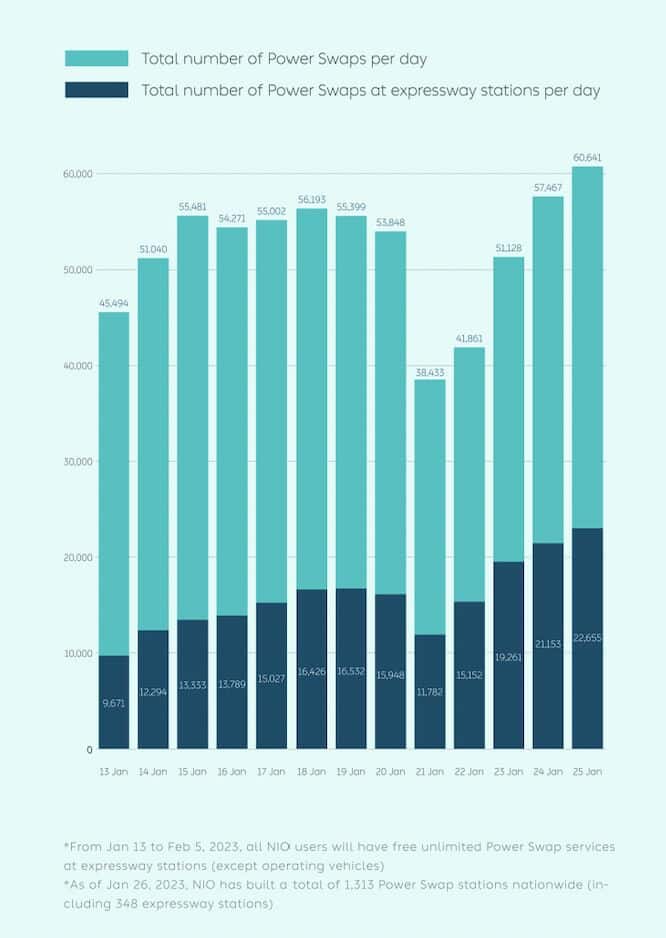Sign up for daily news updates from CleanTechnica on email. Or follow us on Google News!
Most of the heavy electric trucks on the road to date are in China. As of 2022, China sold 36,000 electric trucks, 91% of the total. No country other than China ever sold over 1,000 electric trucks in a year. In heavy electric trucks, China is by far the largest user.
This lead continued into 2023, with Europe gaining a larger share but China still in the lead.
China’s motivation for heavy-duty electric trucks is that heavy-duty truck emissions exceed light-duty emissions by 50%.
China is also the largest single market for electric cars, and the electric car battery swapping market is significant. There, the government supports electric vehicle battery swapping. The Chinese government has announced support for standards for EV battery swapping.
CleanTechnica author Michael Barnard has noted that standardization is a key systems factor in battery swapping. The difference in standardization efforts and government support for swapping is evidenced in China’s greater use of swap systems in both cars and heavy trucks compared to both Europe and the US.
In Mr. Barnard’s evaluation, five items were listed as factors, requirements, conditions for success, or situations for swap feasibility. The first two are situations, the last three are combined factors for swap feasibility.
- Manual swap
- Standard shipping containers compatible with shipping equipment (i.e., cranes, etc.)
- Fleet — this one has a more lengthy word description.
- The swap market is very big and dominated by a few manufacturers. A comparison example: cement mixers.
- A government initiative to drive battery swapping.
Looking at the results so far, these conditions seem to be largely evidenced empirically. My evaluation seems to indicate that standardization is the most critical factor. For cars, with fast chargers already established, the need for swap is not that great, unless car charging levels stray far beyond 150 kW. Already, car fast charging costs are greater for faster charging exceeding that level. This seems to be tolerable and the need for swap is not great for cars. For the most part, a discussion of practical swap and fast charging applications only involves heavy trucks, machinery, and long-haul transport that involves large amounts of power in charging, in agreement with the listed conditions.
Since most car charging is low power in homes, swap is more of a long trip factor than a daily use factor for cars in general.
For heavy trucks with frequent all-day operation, charging is more frequent and operational time is at a premium. The difficulty lies in the elevated levels of power required for fast charging. I do not believe charging heavy trucks and other vehicles can be always time shifted to times of lower power to avoid excess utility charges or that buffering fast chargers universally solves this problem. For example, in California, the premium rate time is a short period of about six hours in the early evening. With solar in abundance, there is no day–night arbitration and rates are low at midday. That leaves little opportunity for arbitrage in charging.
The analysis of relative charging costs for battery-buffered fast chargers versus slow-charging swap for heavy trucks depends mostly on the differences in capital equipment costs. Buffered fast charging only adds value for charging avoiding use during premium rate times. Only a limited amount of use cases require charging during those times. For most of the hours of operation, buffered charging would gain little or no advantage. The battery packs on electric vehicles themselves can serve as time shift.
Further, the use of battery-buffered charging arbitration only extends to the amount of buffering available. If more charging is necessary, further buffering is needed. For a period of several hours, the battery buffer must be recharged and is not available for fully charging a battery pack. To charge more battery packs, in the senescent period, further battery buffers are needed to avoid demand charges or higher TOU rates. This is the case with all high power charging systems.
In general, it is not possible to attain a level of arbitration solely on the difference between peak rate times and low rate times, simply because some heavy vehicle pack charging is not limited to specific times of day. Heavy truck charging based on overnight slow charging does not meet use patterns. For long-haul heavy trucks, the recharging cycle periods can be from three to eight hours.
Vehicles need to charge as routes and situations require
The heavy vehicle swap charge advantages versus buffered fast charging remain a key difference inherent in slow charging swap. Peak power demands in distribution equipment must be met regardless of time of day. Costly grid upgrades have so far been avoided with cars because the power levels are low relative to existing grid capabilities. Utilities will incur heavy capital expenses to upgrade grids to levels an order of magnitude greater that are needed to power trucks. The problem is chiefly that heavy trucks, particularly semis, need to operate at a very high use rate, and charging power is very high compared to cars with low use rates that can be charged very slowly. Heavy trucks have to charge more frequently and at much higher levels. An electric car could fully charge once and drive for days, but an electric long-haul truck could fully charge twice in a day or more.
It is my purpose to outline and show the nature of the charging problem presented to heavy trucks, particularly long-haul trucks and use cases that cannot slow-charge when not in use, and must keep charging costs low to compete with diesel.
Finally, on the balance, it appears that some heavy truck charging decisions are based on maximizing vehicle operating time. In this case, swap may take precedence because of the high need.
Electric car battery swapping in China
With over 85% of the world’s battery pack swapping stations, and a large portion of the world’s fast chargers, no discussion of battery swapping or EVs is complete without a discussion of China. In China, on holidays, electric car owners wait up to an hour to use fast chargers, and an average of 50 minutes to charge. The situation has already drastically improved for battery swap cars. While people in the West choose electric cars with faster charging speeds and larger battery packs, in China, many drivers are opting for the ease of use of battery pack swap cars. In China, owners have the option of owning a battery swap capable car or buying a swap capable car and renting the battery under the Battery as a Service (BaaS) model. The latter provides a lower initial cost to EV buyers. Swapping adds the additional benefit of reduced pack technology obsolescence and reduced battery pack risks and vehicle capital costs.
In heavy trucks, CATL has started a battery swap initiative with the entry of its QIJI battery pack.
The Ministry of Industry and Information Technology is the main EV regulatory body.
“In June 2023, Xin Guobin, the vice minister of the industry, announced that China is going to push towards a universal standard of battery size, connection points, and protocols to facilitate the growth of battery swapping,” according to Nio.
A swap station has many battery packs in it. Nio claims, “it only needs one third of the space, and one third of the grid connection” (at 2:25). It can use lower power equipment requiring less power from the grid, a cost advantage.
A regular commenter, JP, enumerated the relative charging costs as:
- Cost of energy in
- Cost of land
- Cost of non-land capital
- Opportunity costs of capital
On 1, the cost of energy is lower than fast charging with slow-charged swapping, for the fast charging case with or without storage buffer. In the case without buffer, because of extra demand charges, swapping is lower cost. In the case of fast charging with storage buffer, because of the extra 80% round trip energy losses of the storage pack, swapping is also lower cost.
On 2, the cost of land is less for the swap station, because the area is smaller.
On 3, the cost of capital for the swap station is balanced against the extra cost of storage buffers needed to shave peak power. The slow-speed swap station also balances cost versus fast charging without storage, because slower-speed swapping station chargers are cheaper than faster chargers.
On 4, the extra wait time for fast charging adds operational costs, with heavy trucks particularly sensitive to being out of operation during longer charging sessions.
On three out of four of the considerations, swapping batteries has the advantage. On item three, the extra cost of swap hardware is balanced by the cost of either storage needed to avoid peak demand charges or the higher cost of fast chargers versus slow chargers used in swapping stations.
For cars, adequate solutions for long-distance travel already exist as long as charging speeds and power are at 150 kW levels. Where standardization and government support exists, swapping can be used along with fast charging for long-distance travel. For heavy trucks, there are significant costs associated with energy storage likely to push consideration of relative costs of swapping versus fast charging.
To gain some perspective on highway swapping station use versus fast charging use in China, consider the numbers:
Some 60,000 NIO swaps are done on a peak day in China.
For reference, Tesla is the largest DC fast charging provider in China. Tesla Superchargers average 35 sessions per stall per week, or 5 per day. In 2022, there were about 1,000 Supercharger stations. Now, there are 1,900. The number of stalls averages about 10× the number of stations, so 19,000 estimated. With 1,900 Superchargers, the number of daily sessions is about 9,500.
If the NIO numbers from the chart are correct, they have about 348 expressway stations that did about 22,000 swaps per day at the beginning of this year. These calculations indicate that highway swaps per day are happening at a significant rate compared to Supercharger sessions per day in China.
We will continue this discussion of electric car & truck charging in another post or two coming soon.
Have a tip for CleanTechnica? Want to advertise? Want to suggest a guest for our CleanTech Talk podcast? Contact us here.
Latest CleanTechnica.TV Videos
CleanTechnica uses affiliate links. See our policy here.
CleanTechnica’s Comment Policy






